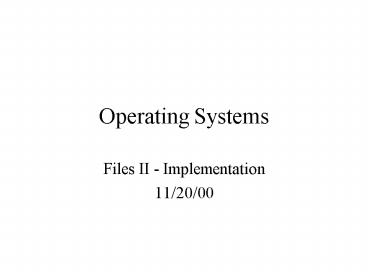Operating Systems - PowerPoint PPT Presentation
1 / 21
Title:
Operating Systems
Description:
Sometimes use a block status map (disk bitmap) -- the ith entry is set if the ... approach has the same problems bitmaps had when dealing with memory. Reading ... – PowerPoint PPT presentation
Number of Views:41
Avg rating:3.0/5.0
Title: Operating Systems
1
Operating Systems
- Files II - Implementation
- 11/20/00
2
File Implementation - Low Level
- Sequential vs. random access storage devices
- Secondary storage devices have
- volume directories
- external file descriptors (for each file)
- the files
- Block management
- assigning blocks to files
- keeping track of free blocks
3
Opening a file
- Locate file descriptor in file system
- Extract info about file from file descriptor and
info about process from process descriptor - Verify that process may access file
- Create an entry in the file status table
- Allocates I/O buffers (and other resources) to
handle file usage
4
Closing a file
- Complete pending operations
- Release I/O buffers
- Release any locks the process holds on the file
- Updates the external file descriptor
- Deallocates the file status table entry
5
(No Transcript)
6
(No Transcript)
7
Contiguous Allocation
- Random device behaves like a sequential one
- Sequential blocks may be accessed quickly (little
head movement on the device) - May not have dynamic file sizes
- Tends to promote external disk fragmentation
8
(No Transcript)
9
Doubly linked lists - to improve performance
10
(No Transcript)
11
Unix
12
Unallocated blocks
- System uses a free list to monitor/keep track of
- Use a linked list or an indexed list
- Usually very large, so indexed list not good
- Using a ll, not easy to allocate disk blocks in
the same area - Sometimes use a block status map (disk bitmap) --
the ith entry is set if the ith block is
allocated - This approach has the same problems bitmaps had
when dealing with memory
13
Reading/Writing blocks
- 2 steps
- reading/writing to/from memory copy of block
- reading/writing memory lt---gtstorage devices
- Reading (unpacking) -- converting secondary
storage blocks into a byte stream - Writing (packing) -- moving bytes into copies of
secondary storage, and writing them to secondary
storage blocks when they become full
14
Tricky operations
- Insertion/Deletion
- Seeking
15
(No Transcript)
16
Block I/O
- For performance reasons, block buffering may be
used - Information is generally accessed sequentially
17
Other levels of file implementation
- Structured sequential files -- a full record is
read at a time - Indexed sequential files
- multiple records in 1 block
- each block gets its own record
- buffering doesnt help
18
Other levels (contd)
- DBMSs
- use a storage manager instead of a file manager
- specialized strategies for different DBs
- Multimedia
- documents generally implemented via abstract data
types - high bandwidth throughput
- multiple blocks requested at once
19
Memory mapped files
- File access is more complicated than regular
memory acess - Some OSs allow mapping of files into a running
process AS - MAP, UNMAP
- file becomes the backing for the file
- works best in a system that supports segmentation
20
(No Transcript)
21
Problems
- Hard to know exact lengths of output files
- Inconsistencies if file is opened for writing by
1 process, but conventional read by another - File may be larger than the segment































